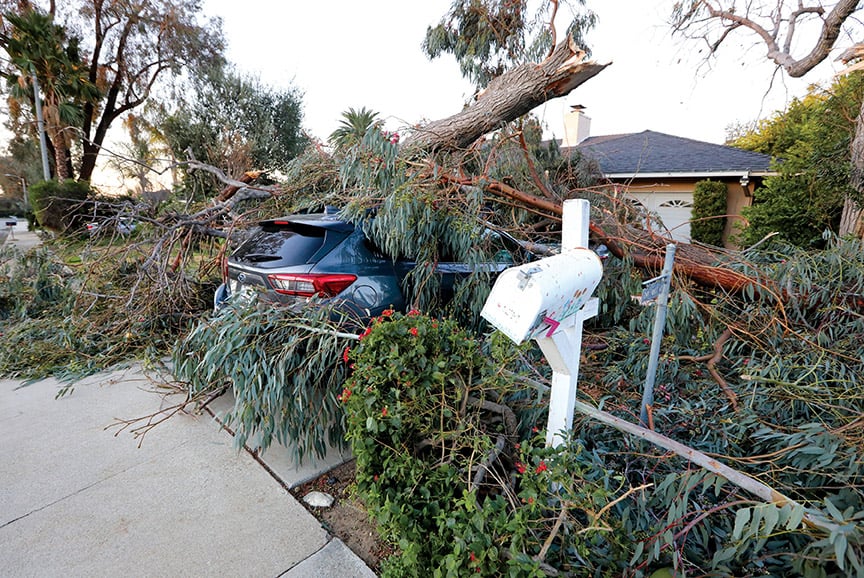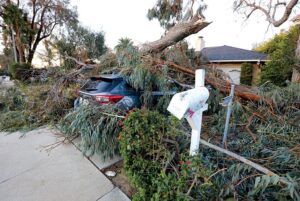Plan to remove thousands of trees a surprise in the ‘city of trees’

by Steven Felschundneff | steven@claremont-courier.com
Claremont has recently released the results of a comprehensive audit of its urban forest, and some residents are alarmed that an associated mitigation plan calls for the removal of a large number of mature trees.
Following the devastating windstorm last year, the City Council authorized West Coast Arborist to conduct an urban forest condition assessment to identify any trees that may be at risk of falling due to damage sustained in the storm. West Coast Arborist also provided an overall evaluation on the health of Claremont’s city-owned trees.
The results of the assessment and an associated mitigation plan were presented to the Claremont Tree Committee on February 13, and were then forwarded to the community and human services commission for further consideration
“Overall, the assessment indicated that the urban forest was in generally good health; however, they found that certain species of trees were more affected by the windstorm than others and that these species were at a greater risk of failure should another windstorm of the same magnitude occur,” according to a staff report from Community Services Director Jeremy Swan.
The mitigation plan identified Italian stone pine, red ironbark eucalyptus and Canary Island pine as being the most prone to failure in the case of another storm. Furthermore, it recommended that these three types of trees be removed and replaced with other species over a five-to-10-year period.
According to the community services department, 34 Italian stone pine, 20 red ironbark eucalyptus and 20 Canary Island pine fell during the windstorm, whole another 19 of these three types are considered high risk and should be cut down now. There are 108 Italian stone pine, 408 red ironbark eucalyptus and 848 Canary Island pine remaining, all of which would be replaced over time.
“The assessment also identified potential high-risk trees of all species,” read the staff report. “Potential high-risk trees include those that are diseased/declining, dead, or structurally unstable. There were approximately 530 trees identified as potentially high-risk.”

A red ironbark eucalyptus lies on top of a vehicle the morning after the devastating windstorm in January 2022. An audit of the city’s urban forest recommends that all red ironbark eucalyptus, and two species of pine trees, be removed and replaced. Courier photo/Steven Felschundneff
The sheer number of removals caught the attention of a few Claremont residents who wondered why removal is the only remedy presented in the mitigation plan. In addition, they have questioned the decision to enlist West Coast Arborist to perform the analysis when that company would also be performing the tree removal work.
“It’s true, aging urban forests such as ours do require tree removal and replacements, but the mass tree removal that is being proposed here was not the result of detailed assessments,” said arborist and Claremont resident Drew Ready. “Our trees provide so much value to our cities and for this reason, for all but the most high risk of trees — those that are dead, dying or diseased — more thorough risk assessments are warranted.”
“It is questionable that entire species should be removed when only a small percentage of the trees fell during the windstorm and only a tiny percentage of those remaining are high-risk,” Bob Gerecke wrote to the community and human services commission. “I hope that you will request a second opinion from an independent expert source which is not under contract with our City to trim, remove and replace trees. The contract status of WCA gives at least the appearance of a conflict of interest.”
During her comments at the February 13 Claremont Tree Committee meeting, Community Services Manager Cari Dillman said the department has taken a more proactive approach to maintaining the urban forest, including diversifying the species that can be used as street trees as well as planting the right tree in the right place. Street trees can also be identified for removal during the city’s routine “grid trim” maintenance schedule.
The mitigation plan was headed for the consent calendar during the March 1 community and human services commission meeting until some residents took notice and spread the word. Only a commissioner can pull an item from the consent calendar, so people like Gerecke, Ready, and Jennifer Jaffe were concerned an important decision like the removal of thousands of trees was going to get scant public input.
In response to public concern, staff initially moved the mitigation plan to the administrative items portion of the agenda so that residents would have the opportunity to comment. However, on Tuesday Swan said in an email that the plan had been pulled from the agenda altogether so that his staff could conduct further research.
“We are going to complete further analysis and review of the item and bring it back at a later date,” Swan said.
“When it comes to pine trees that line our streets, every tree is not a nail, and our only tool is not a hammer. Like any good hazard mitigation plan, we should use the utmost care in developing long-term strategies that will reduce negative impacts on people, property, and the environment,” Ready said. “Cities such as Seattle, Santa Monica, and Los Angeles are employing creative solutions to sidewalk repair around trees. Claremont has always been a leader when it comes to planting and maintaining our urban forest. We can lead when it comes to sidewalk repair as well.”
It may seem like preaching to the choir in Claremont, but mature trees provide badly needed shade in the hot summer months and have been shown to significantly reduce surface temperatures. Trees absorb carbon which can offset climate change and improve air quality. They also just make for a nice environment where people live.
It could take decades for the newly planted saplings to equal the positive effects of mature trees. Plus, the onus to keep new street trees watered is the responsibility of individual property owners, so there is no guarantee residents will keep them alive.
“We all experienced the trauma of the 2022 windstorm and the fallen trees,” Jennifer Jaffe wrote in an email. “We who opposed the City’s tree removal plan do support tree removal when necessary. But that determination must be based on third-party expert analysis and recommendations, full exploration of viable alternatives to removal, and a robust public process. None of that was true for the City staff’s proposed plan. And it wasn’t true of our public process, which yielded no public awareness or public comment on the true nature of the plan that was described as a “windstorm mitigation,” but recommended removal of 100’s of trees for reasons unrelated and inadequately considered.”









0 Comments